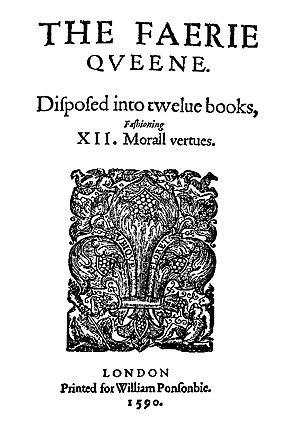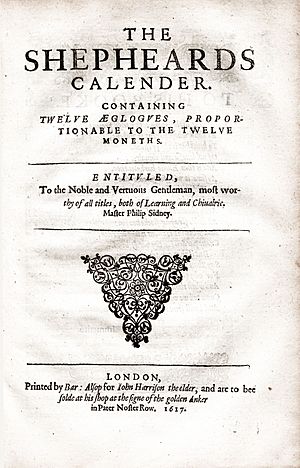Edmund Spenser facts for kids
Quick facts for kids
Edmund Spenser
|
|
|---|---|
 |
|
| Born | 1552/1553 London, England |
| Died | 13 January 1599 (aged 46–47) London, England |
| Resting place | Westminster Abbey |
| Occupation | Poet |
| Language | Early Modern English |
| Alma mater | Pembroke College, Cambridge |
| Period | 1569–1599 |
| Notable works | The Faerie Queene |
| Spouse | Machabyas Childe (c. 1579–c. 1593, her death) Elizabeth Boyle (m. 1594–1599, his death) |
| Children | 2 |
| Signature | |
Edmund Spenser (1552 or 1553 – January 13, 1599) was a famous English poet. He is best known for his long poem, The Faerie Queene. This epic poem is a fantasy story that celebrates the Tudor dynasty and Queen Elizabeth I. Many people consider Spenser one of the greatest poets in the English language. He helped shape early Modern English poetry.
Contents
Life of Edmund Spenser
Edmund Spenser was born in London, England, around 1552. We don't know the exact date of his birth or much about his parents, but his father was likely a clothmaker.
As a boy, Spenser went to the Merchant Taylors' School in London. Later, he studied at Pembroke College, Cambridge. At Cambridge, he became friends with Gabriel Harvey. In 1578, he worked for a short time as a secretary for Bishop John Young.
In 1579, Spenser published his first major work, The Shepheardes Calender. Around the same time, he married his first wife, Machabyas Childe. They had two children, Sylvanus and Katherine.
Life in Ireland
In July 1580, Spenser moved to Ireland. He worked for the new Lord Deputy, Arthur Grey, 14th Baron Grey de Wilton. Spenser stayed in Ireland even after Lord Grey returned to England. He got other official jobs and lands in the Munster Plantation.
Between 1587 and 1589, Spenser got his main home at Kilcolman, near Doneraile in North Cork. He also bought another piece of land nearby. A local story says he wrote parts of The Faerie Queene under a special tree, known as "Spenser's Oak." This tree was destroyed by lightning in the 1960s.
Publishing The Faerie Queene
In 1590, Spenser published the first three books of The Faerie Queene. He traveled to London to publish and promote his work, likely with help from Walter Raleigh. He was successful enough to receive a payment of £50 a year from Queen Elizabeth I for the rest of his life.
Spenser hoped to get a job at the Queen's court through his poetry. However, his next book included a poem called Mother Hubberd's Tale, which made the Queen's main secretary, Lord Burghley, angry. So, Spenser returned to Ireland. He was part of a group of writers there, including his friend Lodowick Bryskett.
In 1591, Spenser published his translation of sonnets by Joachim du Bellay, called Ruines of Rome: by Bellay.
Later Life and Death
By 1594, Spenser's first wife had died. That year, he married Elizabeth Boyle, who was much younger than him. He wrote a series of love poems called Amoretti for her. Their wedding was celebrated in another poem called Epithalamion. They had a son named Peregrine.
In 1596, Spenser wrote a paper called A View of the Present State of Ireland. This paper was a discussion about how to bring peace to Ireland. It suggested that Ireland needed big changes to its language and customs. This work was not published until many years after his death because its ideas were very strong.
In 1598, during a war in Ireland, Spenser was forced to leave his home by Irish forces. His castle at Kilcolman was burned down. Some say one of his young children died in the fire.
In 1599, Spenser traveled to London, where he died at age 46. He was buried in Poets' Corner in Westminster Abbey. Other poets carried his coffin and threw pens and poems into his grave.
The Queen's Payment Story
There's a famous story about Spenser and Queen Elizabeth I. The Queen supposedly told her treasurer, William Cecil, to pay Spenser one hundred pounds for his poetry. But the treasurer thought this was too much. The Queen then said, "Then give him what is reason."
When Spenser didn't get his payment, he wrote a short poem for the Queen: "I was promised on a time, To have reason for my rhyme. From that time unto this season, I received nor rhyme nor reason."
The Queen immediately ordered the treasurer to pay Spenser the original £100. This story might have actually happened to another poet, but it shows how much Spenser's work was valued.
The Shepheardes Calender
The Shepheardes Calender was Edmund Spenser's first important work, published in 1579. It is a collection of twelve poems, one for each month of the year. These poems are called "eclogues," which are short poems, often about shepherds and country life. They can be a conversation between two people or a single person speaking. Each month's poem stands alone, but together they make up a whole year.
The Faerie Queene

Spenser's most famous work is the long poem The Faerie Queene. The first three books were published in 1590, and another three books were published in 1596. Spenser had planned for the poem to have twelve books, so the version we have today is not finished. Even so, it is one of the longest poems ever written in English.
The Faerie Queene is an allegory. This means it has a hidden meaning, often about morals or politics, that is shown through characters and events. Spenser intended it to be read as praise for Queen Elizabeth I. The poem follows several knights who represent different virtues, like holiness or temperance. Spenser said his goal was to "fashion a gentleman or noble person in virtuous and gentle discipline."
Shorter Poems
Spenser wrote many shorter poems in the late 1500s. Most of these poems were about love or sadness. In 1591, he published Complaints, a collection of poems that express feelings of sorrow or make fun of things.
Four years later, in 1595, Spenser published Amoretti and Epithalamion. This book includes 88 sonnets (a type of poem) that celebrate his courtship with Elizabeth Boyle. In Amoretti, Spenser uses humor while praising his beloved. Epithalamion was written for his wedding to Elizabeth Boyle. The next year, Spenser released Prothalamion, a wedding song written for the daughters of a duke.
Spenser's Poetic Style
Spenser used a special way of writing poetry called the Spenserian stanza. He used this style in The Faerie Queene and other works. Each Spenserian stanza has nine lines. The first eight lines have ten syllables each, and the last line has twelve syllables. The lines follow a specific rhyme pattern: `ababbcbcc`.
He also created his own type of sonnet, called the Spenserian sonnet. In this sonnet, the last line of each four-line group (quatrain) rhymes with the first line of the next group. The rhyme pattern is `ababbcbccdcdee`.
One example is the sonnet "Men Call you Fayre" from Amoretti. In this poem, Spenser writes to his beloved, Elizabeth Boyle, about true beauty. He believed that physical beauty fades, but the beauty of the mind and spirit lasts forever. He says his beloved is not just flesh but also a spiritual being with a pure heart and sharp mind. He praises her spiritual beauty and worships her "Divine Soul."
Influences and Legacy
Spenser read a lot of classical literature from ancient Rome, like poems by Virgil and Ovid. However, his own poetry was unique and didn't just copy old styles. He also admired earlier poets like Geoffrey Chaucer and Petrarch. Spenser often used old-fashioned language in his poems on purpose, to make them sound like older works.
Spenser was a strong supporter of the Protestant Queen Elizabeth I. He was bothered by the messages spread by some Catholics against the Queen. Like many Protestants during that time, Spenser saw the Catholic Church as corrupt. This belief is an important background for the battles described in The Faerie Queene.
Many famous poets admired Spenser. Charles Lamb called him "the Poet's Poet." John Milton, William Blake, William Wordsworth, John Keats, Lord Byron, and Alfred Tennyson were all inspired by his work. Walter Raleigh wrote a poem praising The Faerie Queene, saying he valued Spenser's work more than any other in English.
List of Works
- 1569: Jan van der Noodt's A Theatre for Worldlings (poems translated by Spenser)
- 1579: The Shepheardes Calender (published under the name "Immerito")
- 1579: Iambicum Trimetrum
- 1590: The Faerie Queene, Books 1–3
- 1591: Complaints, Containing Sundrie Small Poemes of the Worlds Vanitie, including:
- 1592: Daphnaïda (an elegy, or sad poem, about Douglas Howard)
- 1595: Amoretti and Epithalamion, containing:
- "Amoretti"
- "Epithalamion"
- 1595: Astrophel. A Pastorall Elegie vpon the Death of the Most Noble and Valorous Knight, Sir Philip Sidney
- 1595: Colin Clouts Come Home Againe
- 1596: Fowre Hymnes
- 1596: Prothalamion
- 1596: The Faerie Queene, Books 4–6
- 1596: Babel, Empress of the East (a poem in another book)
- 1609 (published after his death): Two Cantos of Mutabilitie
- 1611 (published after his death): First collection of Spenser's works
- 1633 (published after his death): A Vewe of the Present State of Irelande (a paper about Ireland)
Images for kids
See also
 In Spanish: Edmund Spenser para niños
In Spanish: Edmund Spenser para niños



